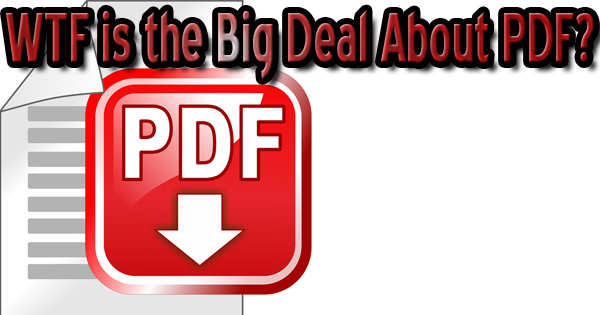
I bet that title got your attention! If you’ve been around computers for any time at all, you’re familiar with PDF documents. If you’ve ever had to scan and e-mail a document, you’ve certainly run into a circumstance where the person required you to send the scanned document in PDF form. So, what exactly is a PDF, and why is this type of file so desired? We’ll start by telling you what PDF stands for: Portable Document Format (PDF). Not familiar with WTF? You can look that one up on your own.
As we mentioned, PDF stands for portable document format. What exactly does that mean? Here’s how Wikipedia defines it: “A file format used to present documents in a manner independent of application software, hardware, and operating systems. Each PDF file encapsulates a complete description of a fixed-layout flat document, including the text, fonts, graphics, and other information needed to display it.” For example, if you were to send a document that was created in Microsoft Word to a person who didn’t have Word installed on their computer, the recipient wouldn’t be able to open your document. Now, if you sent them a PDF instead, there wouldn’t be an issue opening your file. For this reason, you’ll notice that PDF is the file of choice for any forms that are downloaded from the Internet.
Now that we know what a PDF is, how do we create one of our own? If you’re scanning a physical document, choose the “PDF” file format from the scanning menu. Typical options are “TIFF”, “JPG”, or “PDF”. If you’re looking to convert a Microsoft Word document to a PDF, click “Save As”. In the “Save As” window, you’ll type the desired filename for the document, then turn your attention below the filename to the dropdown arrow next to “Type”. Select “PDF”, then click “Save”. Are you a fan of Corel’s WordPerfect? To convert a document in WordPerfect, click “File” then “Publish To”. Choose “PDF” and you’re good to go. How about the freeware word processing software OpenOffice Writer? I personally use it on my laptop. Open the document you’d like to turn into a PDF. Click “File”, then “Export as PDF”. 99 times out of 100 the default settings will work just fine, so click “Export” and you’re good to go. Finally, in Windows 10, the built-in print to PDF feature is an easy way to turn just about anything into a PDF. Open an app that will allow you to print, and click the “Print” button. When the list of printers appears in the window, select “Microsoft Print to PDF”. A PDF file will automatically be saved to the “Documents” library.
PDFs make life easier for both the sender and receiver. There are several programs out there that allow you to view PDF files on your computer. The most popular is the free Adobe Reader. For more on Reader, check out our prior Blog post, “Take Me to Your Reader“. It might be difficult at times to mind your P’s and Q’s, but at least you’ll know “WTF is the Big Deal About PDF!”
